Abstract
Background:
Fatalities from road traffic crashes (RTCs) are a public health challenge for low- and middle-income countries, especially those experiencing epidemiological transition. This paper aims to describe demographics and trend analysis of fatalities of RTCs in Oman from 1995 to 2009.
Methods:
The RTC data from 1995 to 2009 were obtained from the published reports of the Royal Oman Police (ROP). Data were extracted on the distribution of deaths by age, sex, nationality, mode of travel (driver, passenger, pedestrians), and type of vehicle (four- vs. two-wheelers). Trend analyses were carried out using the Chi-square for the percentages of deaths and linear regression for rates.
Results:
A total of 9,616 deaths from RTCs were reported from 1995 to 2009. Of 9,616 fatalities, 4,666 (48.5%) were aged 26-50 years, 7,927 (82.4%) were males, 7,215 (75.0%) were Omanis, and 2,278 (23.8%) were pedestrians. Overall, mortality increased by around 50% from 479 deaths during 1995 to 953 deaths during 2009. There was a significant increase in the proportion of deaths (P < 0.05) and death rates (P < 0.05) among individuals aged 26-50 years, males, Omani nationals, and drivers. The number and rate of RTC fatalities due to overspeeding was also increased (P < 0.05).
Conclusions:
Fatalities due to RTCs in Oman are increasing, especially among those aged 26-50 years, males, drivers, and Omani nationals with overspeeding as a major cause of road traffic fatalities. There is a need for more research in understanding the risk-taking behaviors of young drivers, and sociocultural factors, especially among Omani nationals to target interventions.
Keywords: Fatalities, injuries, national police data, Oman, road traffic crashes
INTRODUCTION
Road traffic crashes (RTCs) are major cause of deaths and disabilities worldwide. Worldwide, RTCs are ranked as the 11th leading cause of deaths and the ninth leading cause of disability-adjusted life-years lost.[1] Every year, about 1.2 million people die because of RTCs with a global mortality rate of 19 per 100,000 in 2002.[2] By 2020, the road traffic fatalities are projected to increase by around 65% globally.[3] According to world report on road traffic injury prevention in 2004, fatalities due to RTCs accounted for more than 50% among young adults aged 15-44 years, and were the second leading cause of deaths among children and adolescents aged 5-14 years and 15-29 years, respectively.[1]
The low- and middle-income countries accounted for 85% of all global annual road traffic According to world report on road traffic injury prevention in 2004, Fatalities, 90% of the disability-adjusted life-years lost, and 96% of all children killed worldwide because of RTCs.[1] The Arab population, which constitutes 3.6% of the world's population, owns 1% of the vehicles of the world but its human losses because of RTCs was estimated to be 4.8% of the losses of the world.[4] In 2002, there were more than 132,000 road traffic fatalities in the eastern Mediterranean Region (EMR) with a death rate of 26.3 per 100,000, one of the highest traffic fatality rates in the world.[4] Also, the EMR has the world's highest rate of road traffic fatalities among young men aged 15-29 years, that is, 34.2 deaths per 100,000.[5]
The Sultanate of Oman, a country in the southern tip of the Arabian Pensula experienced a substantial economic development, which was accompanied by an increased motorization in the last few decades.[6] Currently, RTCs are considered as a major public health concern that challenges the development and progress of the country.[7] Oman has one of the highest rates of road traffic fatalities in the world with around 30 deaths per 100,000 persons. The distribution of rates of road traffic fatalities per 100,000 persons for the Gulf countries, EMR, and globally has been shown in Figure 1.[2] This is one of the first studies that describes demographics and trend analysis of road traffic fatalities in Oman, and identifies the changes in number of deaths and death rates among specific population subgroups.
Figure 1.

Rates of road traffic fatalities in the Gulf countries, Eastern Mediterranean region (EMR), and the world, 2007
METHODS
Setting
Oman has approximately 3,000,000 inhabitants. Around 30% of the country's population is under the age of 15 years. Recent affluence, assisted by the exploitation of hydrocarbon, has sparked substantial economic growth and influx of all façades of modernity in Oman. Currently, Oman has a per capita gross domestic product (GDP) of more than US $25,000 from less than US $1,000 in 1970.[8] Like other low- and middle-income countries experiencing such growth, there is a rapid expansion in the construction of road networks accompanied by a rapid increase in the population with a corresponding increase in the number of vehicles. The entire length of paved roads was barely 10 km in 1970, which increased to more than 23,000 km in 2008, and the number of motor vehicles increased from less than 1,000 in 1970 to more than 750,000 in 2009.[8]
Data source and management
In Oman, RTCs and data of related deaths and morbidities are handled by the directorate of road traffic under the auspices of Royal Oman Police (ROP). The RTC data were obtained from the published reports of the ROP. The ROP defined a road traffic fatality as the event of death from the time of the crash till the closing of the file of the case by January of the following year. Data from 1995 to 2009 were extracted on the distribution of deaths by sex, nationality, mode of travel (driver, passenger, pedestrians), and type of vehicle (four- vs. two-wheelers).
The ROP reports the main cause of all registered RTCs. Each death is then attached to the main cause of the RTC. Most of the road traffic fatalities are caused by overspeeding according to the statistics of the ROP.[9] We, therefore, categorized the causes of deaths in two groups, over-speeding and ‘others’. The ‘other’ group includes all deaths caused other than by overspeeding, for instance, deaths due to overtaking and negligence, and defects of roads and vehicles.
Oman had the first national census in 1993. However, complete reporting of the total population with its age and sex structure started only from 1995. The population data used in the calculation of rate per 100,000 for this study was, therefore, only possible for the period from 1995 onward. These population data were gathered from the annual reports of the Ministry of Health (MOH). The MOH reports the population data in standard five-year age group increments. On the other hand, the reports published by the ROP have their own classification of age groups when presenting the number of deaths [Table 1]. To be able to compute the death rates for each age group, we estimated the total population for each age group according to the ROP data under the assumption that an equal number of people exists in each of the five-year age group categories.
Table 1.
Death rate per 100,000 by age and sex from road traffic crashes in Oman, 1995-2006
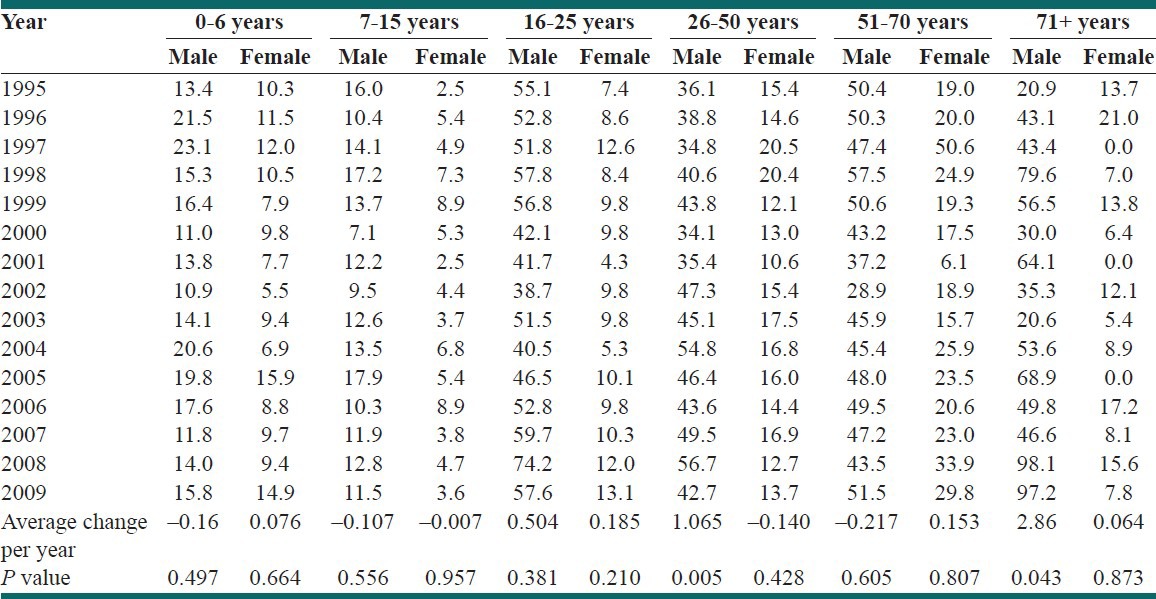
In addition, Oman has a large portion of immigrant work force, mostly from the countries of the Indian subcontinent.[8] We, therefore, gathered gender-specific data on the total number of migrant workers (expatriates) during the same time period.
Data analysis
For each year, death rates caused by RTCs per 100,000 people were computed. In addition, death rates per 100,000 people were also computed for age groups, sex, and nationality for each year. Age groups were divided using ROP cutoff points for reporting deaths by age group. Trend analyses were carried out using the Chi-square for the percentages of deaths of each subgroup. As rates exhibited a normal distribution, we computed linear regression analysis to estimate the annual change per year. A P value less than 0.05 was considered statistically significant. All the analysis was carried out using the SPSS version 19.0.
RESULTS
A total of 9,616 deaths from RTCs were reported by the ROP during the period from 1995 to 2009. Of 9,616 fatalities, 4,666 (48.5%) were aged between 26 and 50 years [Table 1], 7,927 (82.4%) were males, 7,215 (75.0%) were Omanis [Table 2], and 2,278 (23.8%) were pedestrians. The annual number of deaths varied annually from a high of 953 (30 per 100,000) in 2009 to a low of 479 (23 per 100,000) in 1995. Overall, mortality increased by around 50% from 479 during 1995 to 953 deaths during 2009.
Table 2.
Deaths and death rate per 100,000 from road traffic crashes in Oman among males and females by nationality, 1995-2009
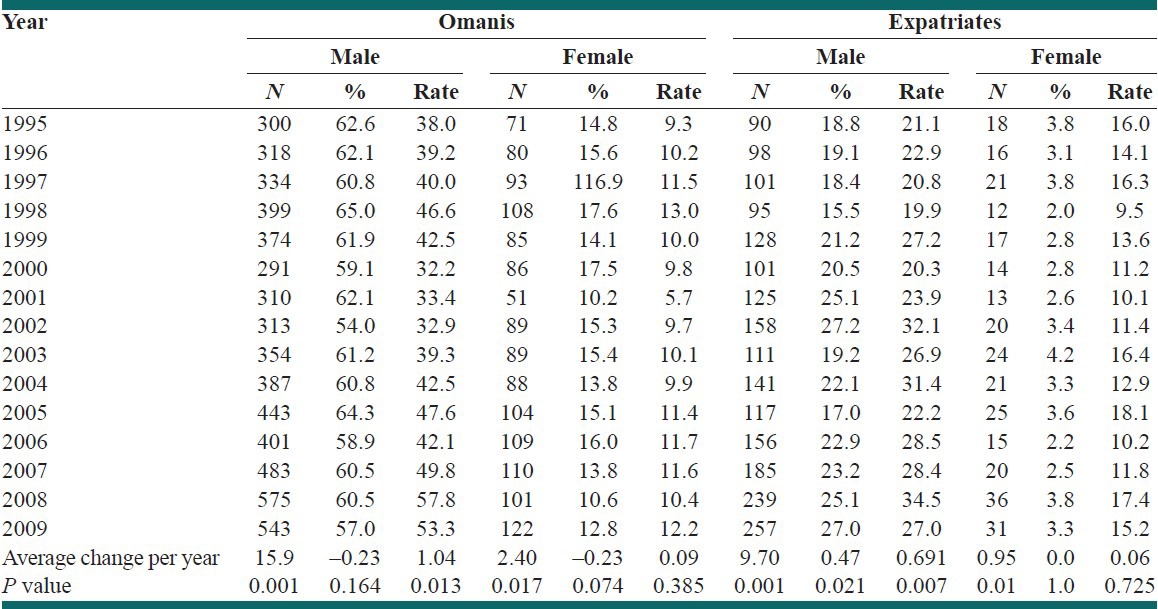
There was a significant increase in the proportion of deaths (42.8 to 49.6, P = 0.009) and death rate (29.6 to 33.9, P = 0.010) among individuals aged 26-50 years during 1995-2009. When stratified by sex, only males showed a significant increase in the death rate (36.21 to 42.7, P = 0.005) but not females (15.4 to 13.7, P = 0.428) [Table 1]. The proportion of deaths decreased from 9.8 to 6.0% (P = 0.004), and 10.4 to 3.7%, P = 0.004 among individuals aged 0-6 years and 7-15 years, respectively. However, the trend of the death rates was insignificant among these age groups.
On an average, the total number of deaths and death rate among males was respectively 4.7 and 3.5 times higher than the total number of deaths and death rates among females during the study period [Figure 2]. Overall, the number of deaths increased among males from 390 (32.1 per 100,000) in 1995 to 800 (40.6 per 100,000) in 2009 (P = 0.004). The number of female deaths increased from 89 in 1995 to 153 deaths in 2009. However, there was no significant change in the death rate among females (P = 0.478).
Figure 2.
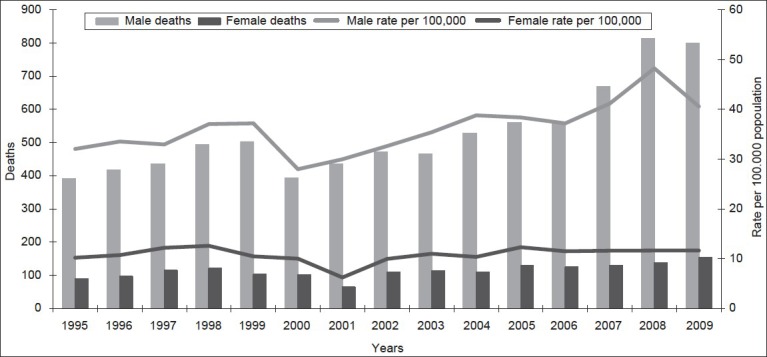
Deaths and death rate per 100,000 from road traffic crashes in Oman
On an average, the total number of deaths and death rate among Omani nationals was 3.6 and 1.2 times higher, respectively, than the total number of deaths and death rates among expatriates during the study period [Table 2]. Overall, the number of deaths and death rate increased among Omani male nationals from 300 (38.0 per 100,000) in 1995 to 543 (53.3 per 100,000) in 2009 (P = 0.001 [deaths], P = 0.013 [death rate]), and those of male expatriates from 90 (18.8 per 100,000) in 1995 to 257 (27.0 per 100,000) in 2009 (P = 0.001 [deaths], P = 0.007 [death rate]). There was no significant change in female deaths rates of both Omani nationals and expatriates (P = 0.385 and P = 0.725, respectively).
Overall, the number of deaths increased among drivers from 156 (32.6%) in 1995 to 417 (43.8%) in 2009 (P = 0.001), and fatalities among motorbikes from 3 (0.6%) in 1995 to 15 (1.6%) in 2009 (P = 0.014) [Table 3] Similarly, the number of deaths and death rate increased due to overspeeding from 187 (39.0%) in 1995 to 499 (52.4%) in 2009 (P = 0.007).
Table 3.
Distribution of road traffic fatalities by mode of travel, type of vehicle and reason for crash in Oman, 1995-2009
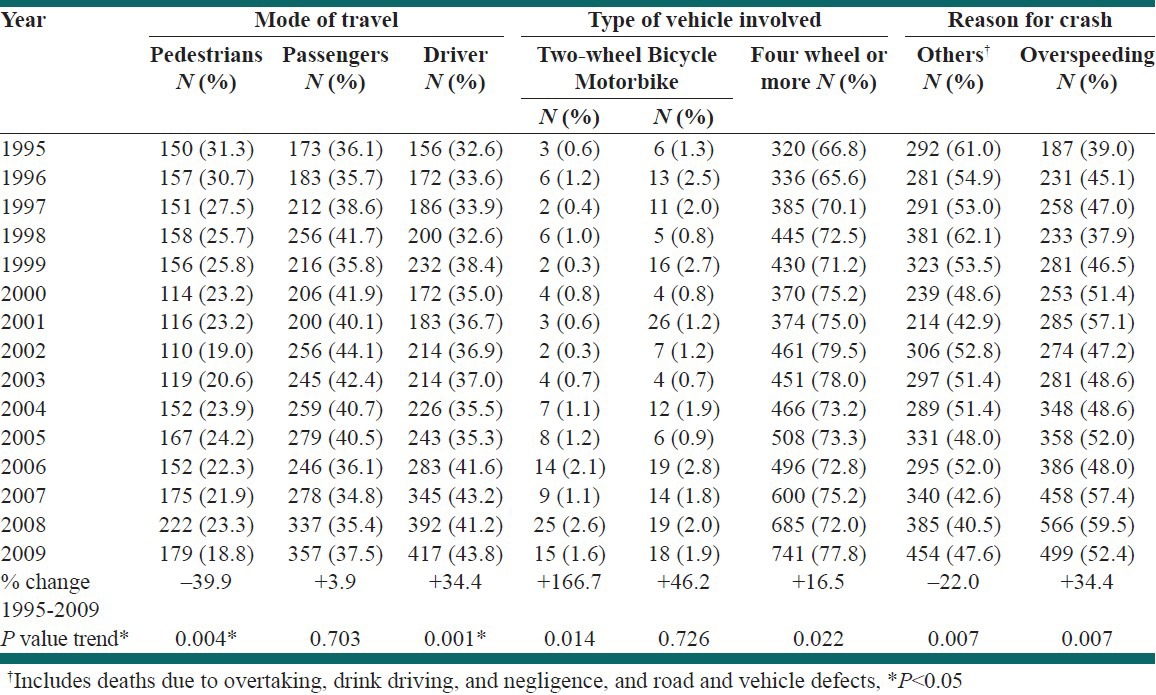
Distribution of deaths of road users by sex showed no significant change in the deaths of female drivers (P = 0.437) and female passengers (P = 0.264) during 1995-2009. However, there was a significant decline in deaths among female pedestrians (P = 0.002) [Table 4].
Table 4.
Distribution of deaths according to road users in Oman by gender, 1995-2009
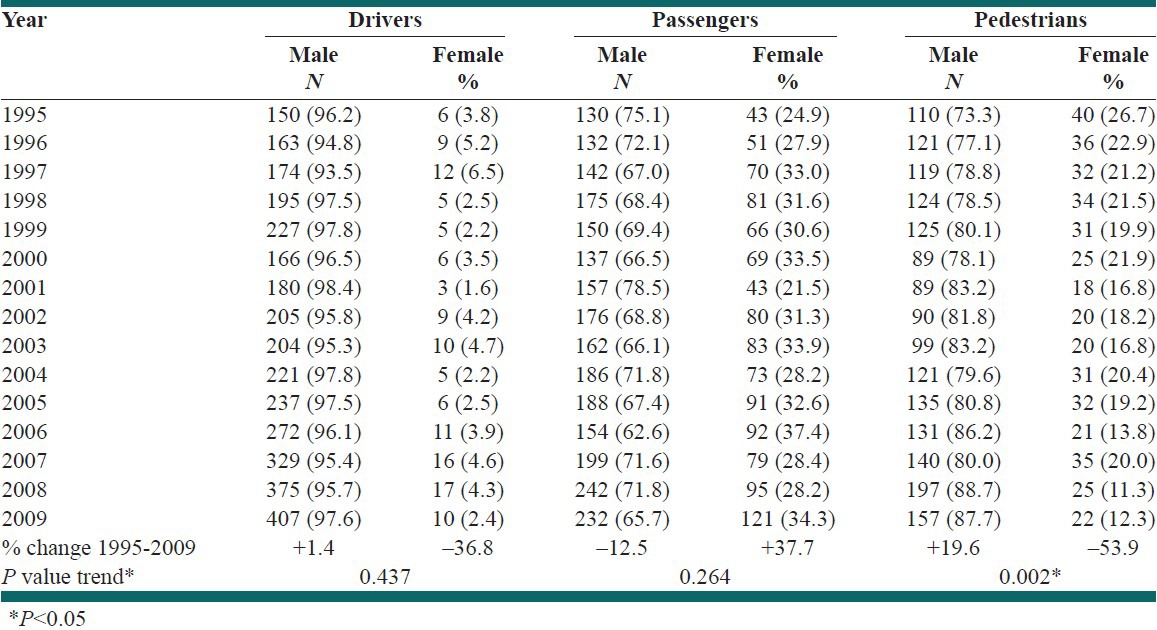
DISCUSSION
The results showed an overall increase in the number and rate of fatalities due to RTCs in Oman from 1995 to 2009. The proportion of deaths was greater among those aged 26-50 years, males, drivers, and Omani nationals with overspeeding as a major cause of road traffic fatalities. Subgroup analyses showed that the trend of number and rate of fatalities due to RTCs increased significantly among those aged 26-50, males, and drivers as compared to pedestrians and passengers. An increasing trend of RTC fatalities was found among four-wheelers. Further, the number and rate of RTC fatalities due to overspeeding was also increased.
The male gender has been described as a high-risk group in the EMR.[1] It has been estimated that males had a death rate two-and-a-half times higher than females in RTC, and males aged 15-29 years and 45-59 years accounted for most of the RTCs in the low- and middle-income countries of the EMR.[1] Similarly, for males aged 45-59 years, the RTC fatality rates in low- and middle-income countries in the EMR were estimated to be 50% higher than the death rate in low- and middle-income countries across the world.[1] Infrastructure of roads may have been unable to meet the increasing demands of rapid motorization and population in Oman, and could have contributed to the increasing road traffic fatalities. However, socioeconomic factors, the ability and attitude of the driver, behavior of the road user, traffic engineering, characteristics of the vehicle, the roads, and the environment may be other contributing factors that may have led to increased road traffic fatalities in Oman.[7]
An increasing trend of road traffic fatalities among drivers as compared to passengers and pedestrians was found in our study. Male drivers, especially those not wearing seat belts, engaged in eating and drinking, using their mobile phones while driving, and having a prior history of traffic violations were found to be at a higher risk for RTCs.[10] Although females are allowed to drive in Oman, they are less likely to be killed in RTCs. This is mainly attributed to the sociocultural issues in the society where men are usually the breadwinners of the families while women are mostly housewives which makes women less exposed to RTCs. Young drivers tend to engage in risky and aggressive driving behaviors that place them at a risk for RTCs.[11,12] Young drivers are usually inexperienced, tend to over-rate their driving skills,[13] and are more likely to drive vehicles of lower quality.[14] This overestimation of driving ability among young drivers has been confirmed by several laboratory-driving simulations.[15,16] Similarly, overspeeding has been documented as one of the main reasons for most of the RTCs in other studies,[10] similar to our study findings. With increasing speed, the risk of crash increases exponentially, and this risk is even more with increasing speed on urban roads than on rural roads.[17] However, traffic characteristics such as flow of traffic, width of roads, and junction density are important factors between speed and crash frequency.[17] Inexperience, risky and aggressive driving behaviors among young drivers, and expansion in the network of roads during the past years in Oman with an increasing number of highways may have been contributing factors for the increasing trend of RTCs due to overspeeding. Although drink-driving is considered as a major risk factor for RTCs in many developed countries,[1] less than 1% of the reported fatalities in RTCs in 2009 were attributed to drink-driving.[9] This could be explained by cultural reasons, as alcohol is forbidden in the Islamic culture. Nevertheless, it could be also due to under-reporting of drink-driving due to legal and social consequences associated with RTCs with such causes.
Oman, in 1982, developed a road traffic committee, followed by mandatory helmet and seat belt laws in 1986 and 1990, respectively; since then, the country has embraced the best practices to ensure road safety and to tackle RTCs in the country.[7] The first survey for road traffic injuries in Oman conducted in 1993 under the supervision of the National Program for Prevention and Control of Road Traffic Accidents resulted in a shift in focus from treatment to prevention.[7] Despite all these preventive measures, the country is still facing challenges such as insufficient specialized manpower, and sociocultural issues like those of macho attitudes, where young male drivers think they have a great control of the car regardless of the speed and conditions of the roads.[7] These reasons may contribute to more RTCs among Omani nationals than foreign nationals. However, the government has responded well to these challenges by implementing a project through the ROP and the research council to automate and improve the reporting system and the validity, reliability, accessibility, and usability of the data. There are developments of a specialized emergency medical service (EMS) system, comprehensive trauma register, and state-of-the art hospitals along with trauma level-one centers that could be instrumental in dealing with victims of road traffic trauma.
Our study is subject to a few limitations. Firstly, the national police data are based on manual reporting of road traffic fatalities to the central authority and thus there may be likelihood of under-reporting of these events. However, deaths are less likely to be underestimated due to the legal implications involved. Deaths reported to the ROP requires involvement of the court for compensations (mostly by the insurance companies) of deaths, in which the ROP is an important party in the legal process during the trials. Secondly, classification of age groups described by MOH and ROP is not the same and thus subject to some misclassification. Lastly, country-specific information on RTCs of expatriates was not available in the reports of the ROP; it was therefore not possible to present the data by the country of origin.
To conclude, the fatalities due to RTCs in Oman are increasing, especially among those aged 26-50 years, males, pedestrians, and Omani nationals with overspeeding as a major cause of road traffic fatalities. There is a need for more research in understanding the sociocultural factors, especially among Omani nationals to target interventions. Additionally, compliance of traffic rules through enforcement, information, and education, especially among young male drivers, awareness campaigns through radio stations and television channels, and alterations to the physical environment such as changes to the transportation infrastructure through roadway design, roadway hazards, and safety features are important measures that may reduce RTCs among vulnerable groups in Oman.
Footnotes
Source of Support: Nil
Conflict of Interest: None declared
REFERENCES
- 1.Peden M, Scurfield R, Sleet D, Mohan D, Hyder AA, Jarawan E, et al. Geneva: World Health Organization; 2004. World report on road traffic injury prevention. [Google Scholar]
- 2.Global status report on road safety: Time for action. Geneva: WHO; 2009. World Health Organization. [Google Scholar]
- 3.Murray CJ, Lopez AD. Alternative projections of mortality and disability by cause 1990-2020: Global Burden of Disease Study. Lancet. 1997;349:1498–504. doi: 10.1016/S0140-6736(96)07492-2. [DOI] [PubMed] [Google Scholar]
- 4.Geneva: WHO; 2004. World Health Organization. The global burden of disease: 2004 update. [Google Scholar]
- 5.Geneva: World Health Organization; 2002. World Health Organization. World report on violence and health: summary. [Google Scholar]
- 6.Al-Lamki L. Life loss and disability from traffic accidents: It is imperative we all act now. Sultan Qaboos Univ Med J. 2010;10:1–5. [PMC free article] [PubMed] [Google Scholar]
- 7.Al-Kharusi W. Update on road traffic crashes: Progress in the Middle East. Clin Orthop Relat Res. 2008;466:2457–64. doi: 10.1007/s11999-008-0439-5. [DOI] [PMC free article] [PubMed] [Google Scholar]
- 8.Muscat, Sultanate of Oman: Ministry of National Economy; 2010. Ministry of National Economy. Statistical Yearly Report. [Google Scholar]
- 9.Royal Oman Police. Muscat, Sultanate of Oman: Directorate General of Traffic; 2009. Royal Oman Police. Traffic Statistics Report. [Google Scholar]
- 10.Burgut HR, Bener A, Sidahmed H, Albuz R, Sanya R, Khan WA. Risk factors contributing to road traffic crashes in a fast-developing country: The neglected health problem. Ulus Travma Acil Cerrahi Derg. 2010;16:497–502. [PubMed] [Google Scholar]
- 11.Clarke DD, Ward P, Truman W. Voluntary risk taking and skill deficits in young driver accidents in the UK. Accid Anal Prev. 2005;37:523–9. doi: 10.1016/j.aap.2005.01.007. [DOI] [PubMed] [Google Scholar]
- 12.Reason J, Manstead A, Stradling S, Baxter J, Campbell K. Errors and violations on the roads: A real distinction? Ergonomics. 1990;33:1315–32. doi: 10.1080/00140139008925335. [DOI] [PubMed] [Google Scholar]
- 13.Fisher DL, Laurie NE, Glaser R, Connerney K, Pollatsek A, Duffy SA, et al. Use of a fixed-base driving simulator to evaluate the effects of experience and PC-based risk awareness training on drivers’ decisions. Hum Factors. 2002;44:287–302. doi: 10.1518/0018720024497853. [DOI] [PubMed] [Google Scholar]
- 14.Williams AF, Leaf WA, Simons-Morton BG, Hartos JL. Vehicles driven by teenagers in their first year of licensure. Traffic Inj Prev. 2006;7:23–30. doi: 10.1080/15389580500412044. [DOI] [PubMed] [Google Scholar]
- 15.McKenna FP, Crick J. Experience and expertise in hazard perception. In: Grayson GB, Lester JF, editors. Behavioral Researchin Road Safety. Crowthorne, UK: Transport and Road Research Laboratory; 1991. pp. 39–45. [Google Scholar]
- 16.Finn P, Bragg BW. Perception of the risk of an accident by young and older drivers. Accid Anal Prev. 1986;18:289–98. doi: 10.1016/0001-4575(86)90043-6. [DOI] [PubMed] [Google Scholar]
- 17.Aarts L, van Schagen I. Driving speed and the risk of road crashes: A review. Accid Anal Prev. 2006;38:215–24. doi: 10.1016/j.aap.2005.07.004. [DOI] [PubMed] [Google Scholar]


